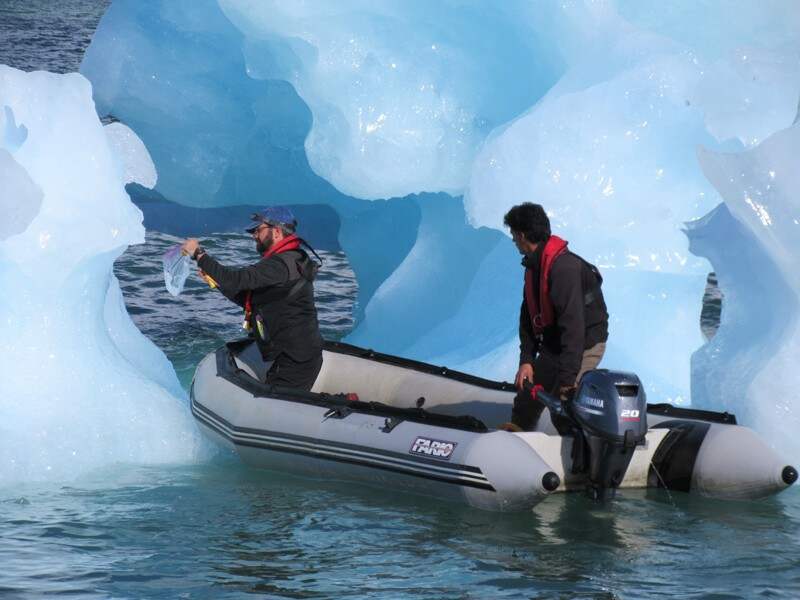Moffat has studied coastal systems in some of the most remote regions of the world such as Patagonia and Antarctica, observing how the ocean plays a large role in explaining the patterns of ice loss from continents, which contributes to global sea level rise. As more of that ice on land melts, the mean sea level is increasing around the world.
Now, having been awarded a five-year, $787,528 National Science Foundation (NSF) Early Faculty Career Development Award, Moffat will look at a challenging scientific problem faced by polar physical oceanographers: trying to determine and understand how all this added freshwater as a result of ice melt affects the coastal systems in Antarctica.
Specifically, Moffat will try to discover where the freshwater ends up and how it impacts the circulation and the properties of the ocean around Antarctica.
That meltwater forms strong coastal currents and ocean fronts, and those currents are impacted by winds, tides, and break down if they become unstable. Aside from generating those currents, the distribution of freshwater in polar oceans strongly modulates the distribution of marine organisms, the magnitude of ocean mixing, and the formation and melting of sea ice, among others.
“We know surprisingly little about those processes in polar regions, and the CAREER grant gives me an opening to study them,” said Moffat, who works in the School of Marine Science and Policy in UD’s College of Earth, Ocean and Environment. “We are trying to study a part of the ocean where it is really risky and complicated to collect observations.”
One of the reasons this problem has been so hard to study is that the meltwater, because it’s lighter, rises, and it also accumulates near the coast. Those surface regions near the coast are heavily impacted by different kinds of ice, including icebergs that break off from glaciers and sea ice that is formed in the ocean itself.
To conduct his research, Moffat will go to the west Antarctic Peninsula — the region he is using as a model for the study — in January of 2022. Moffat said that he chose the west Antarctic Peninsula because it is a region of the world that warmed quickly in the 20th century and it has been one of the fastest warming regions in the Southern Hemisphere.
Once he arrives at his study site, he will deploy some instruments to study freshwater discharge from the coast. He is hoping to utilize observations that are connected from the atmosphere and from the ocean, as well as autonomous vehicles in his research.
“There are autonomous vehicles that you can drop from a ship or one of the Antarctic bases in that region and program them with a mission to collect observations,” said Moffat. “The idea is that next summer, we will program two of these vehicles to sample a pretty broad region of the coast, and we’ll collect oceanographic data including salinity, temperature, and some microstructure data, which allows us to understand mixing processes.”
In the meantime, he will begin modeling work on the region at UD.
Moffat said he became interested in this problem because it is a good example of how processes that are happening close to the coast and in relatively small places — sometimes even underneath ice sheets and small glaciers themselves — are having a big impact on the global climate system.
“Understanding the process of what is happening in that point of contact between the ice and the ocean and the processes that explain how fast the ice is melting at that boundary is critical to understand sea level rise,” said Moffat. “That ocean-driven process of melting is a key source of uncertainty for sea level rise projections.”
Educational Component
In addition to his research, Moffat said he hopes to achieve multiple educational goals from the grant, the first of which is generating a new class focused around polar oceans and polar problems.
Another central effort of the proposal is to have a Professional Learning Institute that will bring in teachers of grades 8-12 over two consecutive summers to train at the University. Over the course of a few days, Moffat and his colleagues will translate some of the research from Antarctica into material that can be used in the teacher’s respective classrooms, especially in terms of the Next Generation Science Standards for Delaware.
In addition, Moffat will use what he learns in Antarctica to train a graduate student and will present his research findings at different conferences and public outreach events.
Finally, the School of Marine Science and Policy at UD has been involved in an effort to renovate the basement of Robinson Hall to create a new teaching lab, and Moffat said he will join in those efforts.
“The idea is to make use of those new facilities to create student-driven investigations where we can use tanks and other teaching tools to allow students to have hands-on experiences with problems related to physical oceanography,” said Moffat.


